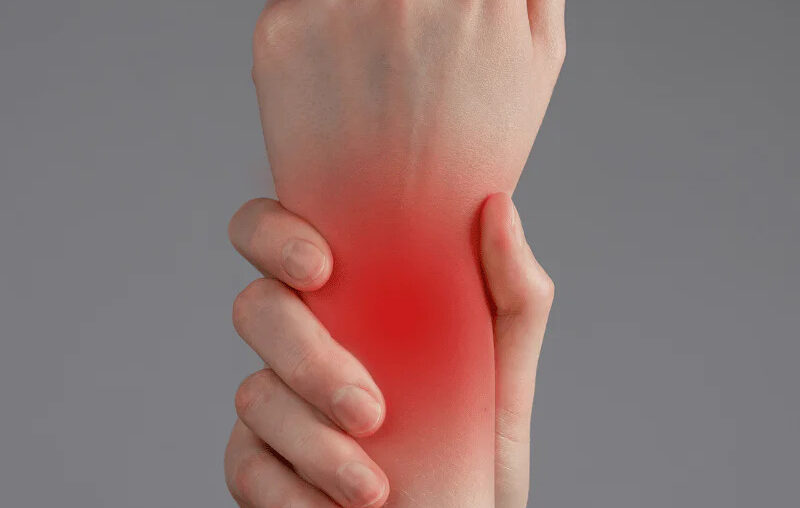When you’re dealing with pain in your wrists or hands, it’s easy to wonder if it’s carpal tunnel syndrome (CTS) or arthritis. Both can cause discomfort, but they’re different conditions with distinct causes, symptoms, and treatments. Understanding the difference between carpal tunnel and arthritis can help you find the right solution for relief. Let’s break it down in simple terms.
What is Carpal Tunnel Syndrome?
Carpal tunnel syndrome is a condition where the median nerve, which runs through your wrist, becomes compressed. This nerve controls sensations in the thumb, index, middle, and part of the ring finger. When it’s compressed, it causes symptoms like:
- Numbness or tingling in the hand, especially in the thumb and fingers.
- Pain in the wrist, palm, and fingers, which can sometimes extend to the forearm.
- Weakness in the hand, making it hard to grip objects.
- Symptoms are often worse at night.
What is Arthritis?
Arthritis, on the other hand, is a general term for inflammation in the joints. There are many types of arthritis, but the most common are osteoarthritis and rheumatoid arthritis. When it comes to the hands and wrists, arthritis can cause:
- Joint pain and swelling.
- Stiffness in the wrist and fingers, especially after rest or in the morning.
- Difficulty moving the joints due to pain or swelling.
How Do Carpal Tunnel and Arthritis Differ?
Though carpal tunnel and arthritis can both cause wrist and hand pain, they have key differences in their causes and symptoms. Let’s take a closer look.
| Feature | Carpal Tunnel Syndrome | Arthritis |
| Cause | Compression of the median nerve in the wrist. | Inflammation of the joints due to wear and tear or immune system problems. |
| Pain Location | Pain is usually in the wrist, palm, and fingers. | Pain is often in the joints, especially in the fingers and wrists. |
| Symptoms | Numbness, tingling, and weakness in the hand. | Stiffness, swelling, and pain in the joints. |
| Pain Timing | Symptoms may worsen at night. | Pain is typically worse in the morning or after rest. |
| Effect on Movement | Can make it hard to grip or hold objects. | Can make it difficult to move joints, especially with swelling. |
| Treatment | Wrist braces, physical therapy, or surgery in severe cases. | Pain relief medications, anti-inflammatory drugs, or joint replacement in severe cases. |
Symptoms: How Can You Tell the Difference?
If you’re wondering, “Is it carpal tunnel or arthritis?” the symptoms can be the biggest clue. Here’s a breakdown to help you distinguish:
Carpal Tunnel Symptoms:
- Numbness and tingling: This is one of the most common signs of carpal tunnel syndrome. You might feel like your fingers are “falling asleep” frequently, especially at night.
- Pain: The pain tends to be sharp or burning, starting in the wrist and radiating to the hand and fingers.
- Weakness: You may notice that gripping objects is harder. It could feel like you’re losing strength in your hand.
- Worsening at Night: Symptoms typically get worse at night, which can affect your sleep.
Arthritis Symptoms:
- Stiffness: You’ll likely feel stiff, especially when you first wake up or after resting.
- Swelling: Your joints may feel swollen, making it difficult to move your fingers or wrists.
- Chronic pain: The pain from arthritis can come and go, but it’s typically constant, especially when moving the joints.
- Pain with movement: Arthritis pain is often triggered when you move the affected joint.
Can Carpal Tunnel Cause Arthritis?
You might be asking, “Can carpal tunnel cause arthritis?” While the two conditions are separate, they can overlap. Carpal tunnel syndrome is caused by nerve compression, while arthritis is due to joint inflammation. However, in some cases, the inflammation caused by arthritis can contribute to compression in the carpal tunnel. In other words, someone with arthritis in the wrist might also experience carpal tunnel symptoms due to swelling or joint damage.
How Are They Treated?
Since carpal tunnel and arthritis are caused by different factors, they require different treatments.
Carpal Tunnel Treatment:
- Wrist braces: Wearing a wrist brace at night or during activities that trigger pain can help relieve pressure on the median nerve.
- Physical therapy: Stretching and strengthening exercises can help improve wrist function and alleviate symptoms.
- Surgery: In severe cases, surgery may be needed to release pressure on the median nerve.
Arthritis Treatment:
- Medications: Over-the-counter pain relievers, like ibuprofen or acetaminophen, can help manage the pain. For more severe arthritis, doctors may prescribe stronger medications or steroids.
- Physical therapy: Exercises that help improve flexibility and strengthen the muscles around the affected joint can reduce pain and improve mobility.
- Joint replacements: In extreme cases of arthritis, joint replacement surgery may be considered, especially for conditions like rheumatoid arthritis.
Prevention: Can You Avoid These Conditions?
While you may not always be able to prevent carpal tunnel or arthritis, there are things you can do to reduce the risk of both.
- Ergonomics: Whether you’re typing, lifting, or using your hands for any other task, make sure your posture and hand positioning are optimal. This can help prevent carpal tunnel syndrome.
- Regular Exercise: Keeping your muscles and joints strong can reduce the risk of arthritis. Regular movement helps prevent stiffness and improves joint function.
- Proper Hand Care: Stretching and strengthening exercises for the wrist and hand can prevent both carpal tunnel and arthritis pain.
Conclusion
Carpal tunnel syndrome and arthritis may seem similar, but they are different conditions with different causes and treatments. While carpal tunnel is caused by nerve compression, arthritis is caused by inflammation in the joints. Recognizing the difference between these two conditions is important so you can choose the right treatment.
If you’re struggling with hand or wrist pain, it’s important to get an accurate diagnosis. Whether it’s carpal tunnel or arthritis, the right treatment can help you manage your symptoms and get back to enjoying life without the constant pain. If you’re looking for relief, consider exploring products like Carpal Aid Patches to ease your symptoms.




